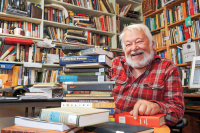Writing to heal the wounds of war

June 2019 marks the twentieth anniversary of The Smoky Mountain News. At the party celebrating this landmark in the paper’s history, Tom Baker introduced himself to me. Tom is the author of The Hawk and the Dove, historical fiction covering military conflicts from the time of the Vikings to the Vietnam War. As Tom, his wife, and I visited, they told me about a writing therapy program for veterans, particularly those with Post-Traumatic Stress Disorder.
The idea behind this program is not that veterans write for publication, though some may do so, but instead seek healing by talking through their fingers to a piece of paper about their past. Those who have trouble expressing themselves to friends and family can often find in the privacy of narrative a way to release their emotions and their trauma.
That next week, poking through the New Book shelves at the North Asheville Public Library, I stumbled across David Constantine’s The Life-Writer (Biblioasis, 2016, 240 pages). After deciding to give the novel a look, I found myself caught up in the story of a woman who turns to writing about the past as a way of battling her own PTSD, brought on not by war but by the death of a husband she deeply loved.
Katrin Swinton is a writer of “brief lives,” insignificant figures of European Romanticism, the writers whose passions matched those of the great figures of the Romantic period, but whose talents fell woefully short. “Each lived a unique life, but at the heart of each was a common lack. Therein, for Katrin, lay their poignancy.”
When her husband Eric dies of cancer, Katrin in her grief loses interest in this project. Instead, driven by a despair that nearly maddens her, she determines to investigate Eric’s life before she knew him, hoping that such an investigation will somehow both recreate him and allow her to live in peace with his death. She rummages through his trunks and satchels of letters in the attic, gleaning his early impressions of the world while still a teenager, his reckless and passionate love affair with a French girl Monique, his later doomed marriage to Edna, his relationship with his best friend Daniel, his failures at Oxford, the distance he maintained from his mother, father, and brother, his love for Katrin.
In her despair, which this investigation of Eric’s life only partially cures, there are two ministers of grace. The first is the aptly named Dr. Gracie, Liz Gracie, who herself is dying of cancer. She counsels Katrin, steering her gently away from anguish, from a wish to die, and back to the land of the living. Though a secondary character in The Life-Writer, Liz Gracie is that friend, that counselor, that human being we would most want with us when we are walking through hell. Katrin’s second companion on this walk is Daniel, an old friend of Eric, a gentle man, a scholar who helps Katrin better understand not only Eric, but herself as well.
Related Items
Oddly enough, the character least understood by the end of The Life-Writer is Eric Swinton himself. Despite Katrin’s investigation and extensive note-taking, he remains a puzzle both to her as well as to readers. We may strongly suspect this sense of mystery may be Constantine’s way of saying how enormously difficult it is to truly understand the human beings we love.
One attraction of this novel is its use of the English language. So much of the fiction we read today, whether in romance, fantasy, science fiction, or suspense, is flat, that is, the authors tell the story, but shy away from elegance and beauty. There are exceptions, of course — the late Pat Conroy, James Lee Burke, and Anne Tyler come immediately to mind — but the great majority of writers assume a prose style that minimalizes description and avoids embellishment.
Not so David Constantine. And I mean that as a high compliment. Here is a poet masquerading as a novelist, a lover of words, syntax, and language capable of blending plot and characters with exquisite descriptions, seamless portraiture. Like all masters of the language, Constantine recreates the sights, odors, and noises of a scene: the streets of Paris, the woodlands and dells of England, the rooms of various houses. In doing so, he often tells us as much about a character as the setting. In his description of the good Dr. Gracie’s surgery, he tells us that it is “spacious and light,” that the walls feature landscapes and “a painting by Gwen John of a girl reading,” that on her desk sit photographs of her husband and two children, that “her glasses give her the appearance of a studious schoolgirl.” The paragraph ends with this lovely duet of sentences: “Behind her there is a garden, an apple tree in flower. And the scents of the garden, a breath of warmth, and birdsong enter the surgery through the slightly opened windows.”
The inner lives of the characters receive this same careful use of language and lyricism. At one point, Michael Swinton, brother of Eric and a recently retired probation officer, reflects on the different ways people react when they have done committed a crime or otherwise done great harm. In this passage, he speaks of those who “did a thing they never dreamed of doing. Either that, or the whole structure was, all along, unbeknownst to them, a very precarious thing. Say the wrong word, put a foot wrong, it collapses, almost innocently you destroy it, you inhabit the ruins ever after and nothing you do will make it right again. That was the very worst, says Michael, dealing with people who had, so to speak, crossed over and would have behind them, forevermore, the irreparatable.”
The Life-Writer is a bottle of fine champagne beside a plate of delicious cheeses, a book, in other words, to be savored. Under the pressures of time and circumstance, I tossed off my glass of champagne and bolted down the cheese.
(Jeff Minick is a writer and teacher. This email address is being protected from spambots. You need JavaScript enabled to view it.)









